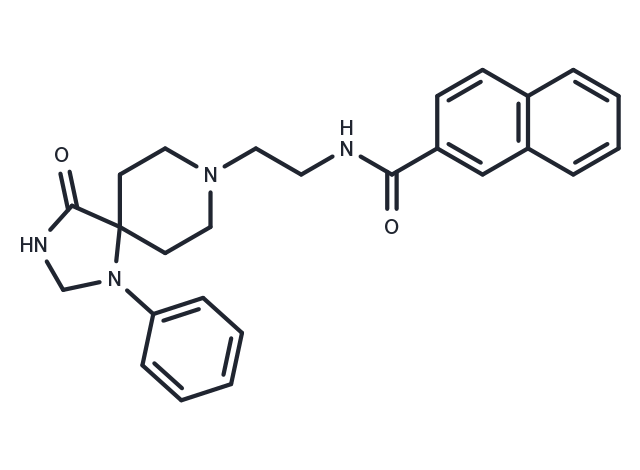Powder: -20°C for 3 years | In solvent: -80°C for 1 year


CAY10594 is a potent phospholipase D2(PLD2) inhibitor. CAY10594 ameliorates acetaminophen-induced acute liver injury by regulating the phosphorylated-GSK-3β/JNK axis.

| Pack Size | Availability | Price/USD | Quantity |
|---|---|---|---|
| 1 mg | In stock | $ 76.00 | |
| 5 mg | In stock | $ 163.00 | |
| 10 mg | In stock | $ 278.00 | |
| 25 mg | In stock | $ 497.00 | |
| 50 mg | In stock | $ 723.00 | |
| 100 mg | In stock | $ 987.00 | |
| 1 mL * 10 mM (in DMSO) | In stock | $ 178.00 |


| Description | CAY10594 is a potent phospholipase D2(PLD2) inhibitor. CAY10594 ameliorates acetaminophen-induced acute liver injury by regulating the phosphorylated-GSK-3β/JNK axis. |
| In vivo | CAY10594 administration markedly blocked the acute liver injury in a dose-dependent manner, showing almost complete inhibition with 8?mg/kg of CAY10594. During the pathological progress of acute liver injury, GSH levels are decreased, and this is significantly recovered upon the administration of CAY10594 at 6?hours post APAP challenge. GSK-3β (Serine 9)/JNK phosphorylation is mainly involved in APAP-induced liver injury. CAY10594 administration strongly blocked GSK-3β (Serine 9)/JNK phosphorylation in the APAP-induced acute liver injury model. Consistently, sustained JNK activation in the cytosol and mitochondria from hepatocytes were also decreased in CAY10594-treated mice. Many types of immune cells are also implicated in APAP-induced liver injury. However, neutrophil and monocyte populations were not different between vehicle- and CAY10594-administered mice which are challenged with APAP. Therapeutic administration of CAY10594 also significantly attenuated liver damage caused by the APAP challenge, eliciting an enhanced survival rate[1]. |
| Animal Research | Mice were fasted for 16?hours before APAP injection. APAP (500?mg/kg) was administered with oral gavage in mice. CAY10594 (N-[2-(4-oxo-1-phenyl-1,3,8-triazaspiro[4,5]dec-8-yl)ethyl]-2-naphthalene carboxamide)23 was dissolved in 1% DMSO and intraperitoneally administered to mice 30?minutes prior to APAP injection for examining protective effects or after 3?hours from APAP challenge for investigating therapeutic effects of CAY10594[1]. |
| Molecular Weight | 428.53 |
| Formula | C26H28N4O2 |
| CAS No. | 1130067-34-3 |
Powder: -20°C for 3 years | In solvent: -80°C for 1 year
DMSO: 20mg/ml(46.7mM)
You can also refer to dose conversion for different animals. More
bottom
Please see Inhibitor Handling Instructions for more frequently ask questions. Topics include: how to prepare stock solutions, how to store products, and cautions on cell-based assays & animal experiments, etc.
CAY10594 1130067-34-3 Metabolism Phospholipase Inhibitor CAY 10594 inhibit CAY-10594 inhibitor
